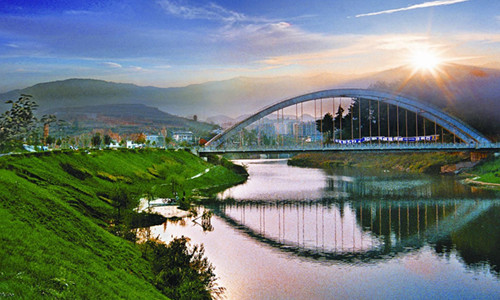

Kaiyang county, on the Yunnan-Guizhou plateau in the southwestern part of China, is reputed to be the "Capital of Phosphorus" for its rich phosphorus resources. Since the establishment of Manzhou in the 4th year of the Zhenguan Reign (627--649) of the Tang Dynasty dating back nearly 1,400 years ago, it has had several names, including Guangzhou, Kaizhou and Zijiang; it was named Kaiyang County in 1930. Since the founding of the People's Republic of China, it was from time to time under the jurisdiction of Guiyang, Guiding, Zunyi, and Anshun, and, beginning from 1996, it has been under the jurisdiction of Guiyang City.
Kaiyang county is located in the hinterland of the middle part of Guizhou province, with a land area of 2,026 square kilometers. It has a magical and beautiful Karst landform, boasting various well-developed types of Karst geological features and a reputation as a world Karst geological park.
Kaiyang is located at 27 degrees north latitude, and has an average elevation of 1,200 kilometers. With a number of rivers in the county, it has a pleasant climate thanks to its low latitude, high altitude and abundant water resources. There are no hot summers or cold winters. The forest coverage rate in the county is 54.33 percent, the highest in central Guizhou. Known as a natural oxygen bar, it has been listed among China's 100 towns for best air quality.
Kaiyang is located between Guiyang and Zunyi, two major cities in Guizhou. It has convenient transportation and smooth logistics based on three operating highways and another under construction. In addition, it has two freight railways and one intercity light rail transit. Kaiyang Port has passenger and freight transport capacities, and is Guiyang's only port for sea-land connection. The Nanjiang General Aviation Port is under construction, with an estimated investment of 900 million yuan.
Kaiyang County has more than 30 kinds of mineral resources, including phosphorus, mercury, and coal. The county is especially known for its phosphate rocks that are of high grade and large reserves. The Kaiyang phosphate mine is one of the famous three major phosphate mines in China. The Kaiyang Phosphorus Chemical Industry Park was one of China's first circular economy pilot parks with its phosphorus chemical products being exported to overseas markets.
Kaiyang enjoys sufficient sunshine, abundant rainfall and long frost-free periods, which is conducive to the growth of crops. As the soil is rich in selenium, the county's selenium-enriched agricultural products, including tea and loquat, have become widely known.
Kaiyang's Shuidong Culture has a long history and the Matou village in Hefeng township is one of the few Shuidong Cultural heritage sites and historical and cultural villages. The newly opened Shuidong Culture Exhibition Hall is the first museum themed on Shuidong culture in Guizhou.
Kaiyang governs eight townships, eight towns, and two communities that consist of 111 villages and 23 neighborhood committees. It has a population of 450,000 people of all ethnic groups, including Han, Miao and Buyi. It has a reputation as an excellent ecological tourism destination. In 2018, it ranked 70th among the top 100 counties in social and economic development in western China.